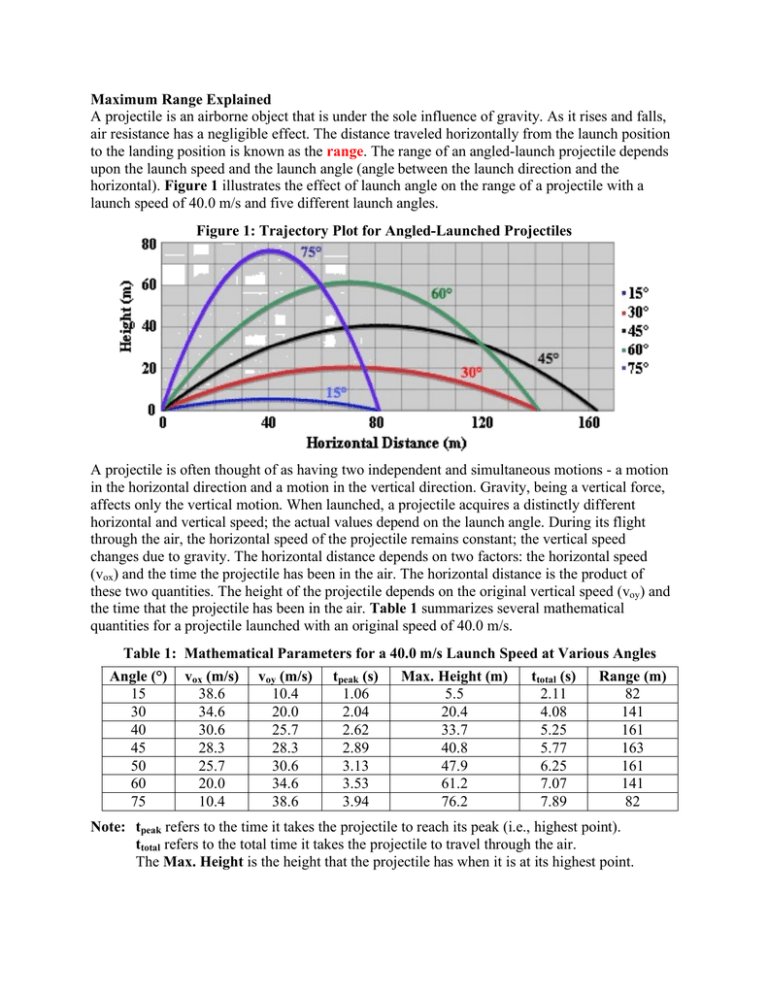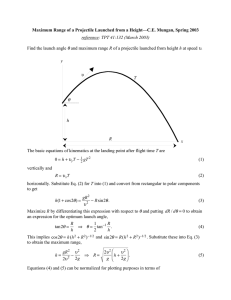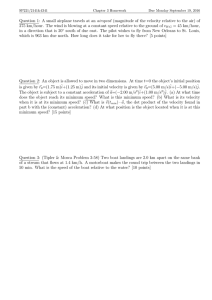Maximum Range Explained A projectile is an airborne object that is
advertisement

Maximum Range Explained A projectile is an airborne object that is under the sole influence of gravity. As it rises and falls, air resistance has a negligible effect. The distance traveled horizontally from the launch position to the landing position is known as the range. The range of an angled-launch projectile depends upon the launch speed and the launch angle (angle between the launch direction and the horizontal). Figure 1 illustrates the effect of launch angle on the range of a projectile with a launch speed of 40.0 m/s and five different launch angles. Figure 1: Trajectory Plot for Angled-Launched Projectiles A projectile is often thought of as having two independent and simultaneous motions - a motion in the horizontal direction and a motion in the vertical direction. Gravity, being a vertical force, affects only the vertical motion. When launched, a projectile acquires a distinctly different horizontal and vertical speed; the actual values depend on the launch angle. During its flight through the air, the horizontal speed of the projectile remains constant; the vertical speed changes due to gravity. The horizontal distance depends on two factors: the horizontal speed (vox) and the time the projectile has been in the air. The horizontal distance is the product of these two quantities. The height of the projectile depends on the original vertical speed (voy) and the time that the projectile has been in the air. Table 1 summarizes several mathematical quantities for a projectile launched with an original speed of 40.0 m/s. Table 1: Mathematical Parameters for a 40.0 m/s Launch Speed at Various Angles Angle (°) 15 30 40 45 50 60 75 vox (m/s) 38.6 34.6 30.6 28.3 25.7 20.0 10.4 voy (m/s) 10.4 20.0 25.7 28.3 30.6 34.6 38.6 tpeak (s) 1.06 2.04 2.62 2.89 3.13 3.53 3.94 Max. Height (m) 5.5 20.4 33.7 40.8 47.9 61.2 76.2 ttotal (s) 2.11 4.08 5.25 5.77 6.25 7.07 7.89 Range (m) 82 141 161 163 161 141 82 Note: tpeak refers to the time it takes the projectile to reach its peak (i.e., highest point). ttotal refers to the total time it takes the projectile to travel through the air. The Max. Height is the height that the projectile has when it is at its highest point. Questions: 1. Using a launch speed of 40.0 m/s and any angle between 0 and 90 degrees, what would be the largest possible range for a projectile? a. 45 meters b. 90 meters c. 163 meters d. 180 meters 2. Based on the given launch parameters, which projectile will reach the highest peak? a. Launch speed = 40.0 m/s; launch angle = 30° b. Launch speed = 40.0 m/s; launch angle = 45° c. Launch speed = 40.0 m/s; launch angle = 60° d. Launch speed = 40.0 m/s; launch angle = 85° 3. Which one of the following rules regarding the relationship between the launch angle and the range seems to best fit the data in Figure 1 and Table 1? a. Any two angles that have a 2:1 ratio will result in the same range when launched at the same speed. b. Two launch angles that add to 90° will result in the same range when launched at the same speed. c. Launch angles that are evenly divisible by 10 will result in a shorter range than those that are not evenly divisible by 10. d. If a large launch angle is evenly divisible (without a remainder) by a small launch angle, then their range will be the same. 4. A golfer is planning to club a ball towards the green but finds a large oak tree to be an imposing obstacle in his way. The trunk of the tree is 50 meters from the golfer. The canopy of the tree can be approximated as a circle with a radius of 15 meters. It extends to a height of 30 meters. Which listed launch angle will allow the golfer to direct the ball over the topmost branches of the tree and still drive the ball as far as possible? Assume a 40.0 m/s launch speed. a. 30 degrees b. 40 degrees c. 45 degrees d. 60 degrees 5. A student observes the following correlation: the time a projectile is in the air (ttotal) increases as the original horizontal speed decreases (vox) and as the original vertical speed (voy) increases. The student wishes to determine which factor (vox and voy), if any, is related to ttotal in a cause-effect manner. Which experiment could be performed to resolve the issue? a. Launch projectiles with random angles and speeds and measure ttotal. b. Launch projectiles at various angles from the top of a cliff and measure ttotal. c. Launch projectiles at one angle with various launch speeds and measure ttotal. d. Launch projectiles straight up in the air at various vertical speeds and measure ttotal. Answers and Explanations: 1. Answer: C Explanation: The maximum range occurs for a launch angle of 45°. At this angle, the range is 163 meters - read from the graph in Figure 1 and listed in the fourth row of Table 1. 2. Answer: D Explanation: This answer can be determined by inspecting the trajectory plots in Figure 1 or the data in Table 1.There are five plots given in Figure 1 with the launch angle increasing by 15° increments beginning with a 15° launch angle. The highest point in the trajectory occurs at the midpoint of the path. This highest point increases as the angle increases. At a 75° launch angle, the maximum height is approximately 76 meters. However, a further increase in launch angle beyond this 75° angle will increase the peak height even more. So the best answer is the launch angle of 85°. 3. Answer: B Explanation: A careful inspection of either Figure 1 or Table 1 reveals that the range of a projectile has an identical value for more than one launch angle. For instance, the range is the same for a 15° and a 75° angle. The range is also the same for a 30° and a 60° launch angle. As a final example, the range is the same for a 40° and a 50° launch angle. What do all these angles have in common? The group of two angles with the same range always add up to 90°. This makes choice b an accurate answer. None of the other choices fit all the data provided in this passage. 4. Answer: D Explanation: Given the description of the physical situation, one can conclude that the golf ball lies 35 meters from the nearest edge of the tree and 65 meters from the furthest edge of the tree. These values were determined by knowing the trunk is 50 meters from the golf ball and the branches stretch from the trunk a distance (radius) of 15 meters towards and away from the ball. Since the branches are as high as 30 meters, it is important that the trajectory of the ball carry it above a height of 30 meters by the time it is 35 meters horizontally from its launch position. When inspecting Figure 1, one can determine that neither the 30° nor the 45° trajectories meet this criteria. Knowing that 40° lies between the 30° and the 45° trajectory means that it can be ruled out as well. By the process of elimination, the only angle that works is the 60° launch angle. 5. Answer: D Explanation: This question pertains to the development of an experimental design to isolate variables having a potential impact upon the flight time of a projectile. The two variables being considered are the original horizontal speed (vox) and the original vertical speed (voy). The best design to determine whether a variable affects the flight time would be a design in which only one variable changes and the other variable is held constant. Conducting an experiment with a changing angle will change both variables. This rules out the first two options. Conducting an experiment involving a constant launch angle but changing speed will also change both variables since vox and voy depend on angle and original speed. This rules out the third option. The best design (of the four options) involves a vertical launch; launching vertically will eliminate the horizontal speed. By changing the launch speed, one can observe the effect of the original vertical speed (voy) upon the time the projectile is in the air.




